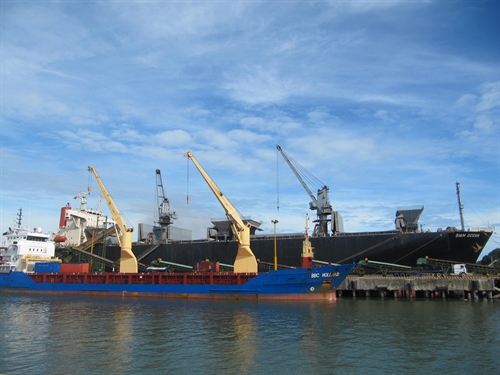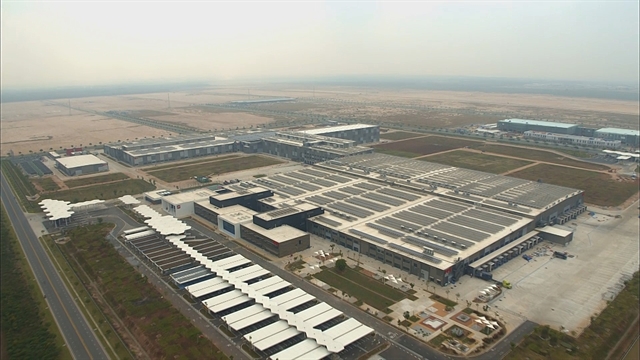 Society
Society

The central city has asked the ministry of transport to allocate funds for key transport infrastructure projects – Liên Chiểu port and the East-West Economic Corridor No 2 (EWEC2) connecting Thailand, Myanmar, Laos and Việt Nam – in 2016-20.
 |
| A section of the National Highway No 1 runs through Đà Nẵng city. The central city will commence a series of key road and port projects to establish the city as the logistics centre of ASEAN and the Asia-Pacific region. — VNS Photo Công Thành |
ĐÀ NẴNG — The central city has asked the ministry of transport to allocate funds for key transport infrastructure projects – Liên Chiểu port and the East-West Economic Corridor No 2 (EWEC2) connecting Thailand, Myanmar, Laos and Việt Nam – in 2016-20.
Vice chairman of the central city’s People’s Committee Nguyễn Ngọc Tuấn, in a working session with the ministry of transport on Friday, said these projects aim to establish the city as a logistics centre in ASEAN and Asia-Pacific as well as encourage sustainable development and ‘green growth’.
Tuấn said the city will start expansion of the National Roads No 14B and 14G, Hải Vân Tunnel, remove a railway station in connection with EWEC2, and upgrade Tiên Sa port later this year.
“The construction of Liên Chiểu port and removal of the railway station alone will cost nearly VNĐ14 trillion (US$622 million). The city will upgrade the second stage of Tiên Sa Port as an integrated cargo and tourist port in the second quarter this year,” Tuấn said.
“We also ask the ministry to allocate funds for land clearance and resettlement for some sections of Hồ Chí Minh Trail and Đà Nẵng-Quảng Ngãi Expressway, and Nam Ô Bridge and the Cổ Cò River waterway system,” Tuấn said.
Tuấn also said the city, in co-operation with Japanese International Co-operation Agency (JICA), will make a pre-feasibility study on the construction of Liên Chiểu port and the EWEC2.
Minister of transport, Trương Quang Nghĩa said almost all transport infrastructure projects would face a deficient fund this fiscal year when mid-term funds only met 11 per cent of approved projects in 2016-20.
“The country needs 116 trillion (US$5.1 billion) for developing transport infrastructure projects in 2016-20, but only 11 or 12 per cent of the proposed funds would be allocated,” Nghĩa said.
“The ministry, in co-ordination with the ministry of finance, will soon reserve funds for top priority projects in serving the Asia-European Co-operation (APEC) in 2017, and key roles for socio-economic development,” Nghĩa said.
“The ministry will soon review the construction of Liên Chiểu port before 2020 and put it into operation in 2025 to ease congestion and overloading Tiên Sa Port,” he emphasised.
He also said the city should look at raising different sources of funds including Official Development Aid (ODA) and domestic and foreign investors in filling up the fund deficiency from the Government.
Nghĩa also warned the city to monitor and implement strict control on waterway transport, traffic violations and overloading of trucks.
He said the boat accident that occurred on June 4th was a tragedy, and has hurt the city’s tourism industry.
On the subject, the city’s party secretary Nguyễn Xuân Anh said the city will ban all modification work in changing fishing boats into cruising vessels.
He said investigation agencies are poised to prosecute the suspect in the boat accident, while some officials have already been suspended.
As scheduled, Liên Chiểu port, which currently handles 50,000 deadweight tonnage (DWT) container ships, will be built to allow access to 100,000-tonne ships and cargo ships with a loading capacity of 8,000 twenty-foot equivalent units (TEUs).
The central city also plans to upgrade Sơn Trà Port for 20,000DWT ships and build up an Inland Container Depot (ICD) to support ports in Đà Nẵng and Chân Mây port in neighbouring Thừa Thiên-Huế province.
A survey from the ministry of transport revealed that Đà Nẵng, which is situated at the end of EWEC, would handle 29 million tonnes of cargo by 2030.
The central city’s port system including Tiên Sa, Liên Chiểu and Sơn Trà has been planned as the biggest integrated port among six seaports in Việt Nam (Quảng Bình, Quảng Trị, Thừa Thiên-Huế, Kỳ Hà, Dung Quất and Đà Nẵng).
According to Việt Nam’s seaport system development plan to 2020, Đà Nẵng Port has been confirmed as a major commercial port in the region, making it one of the key gateways to the East Sea from the sub-Mekong region. — VNS
 |
| Ships dock at Tiên Sa port to unload cargo. The central city of Đà Nẵng plans to upgrade the port for both cargo and cruises. — VNS Photo Công Thành |




